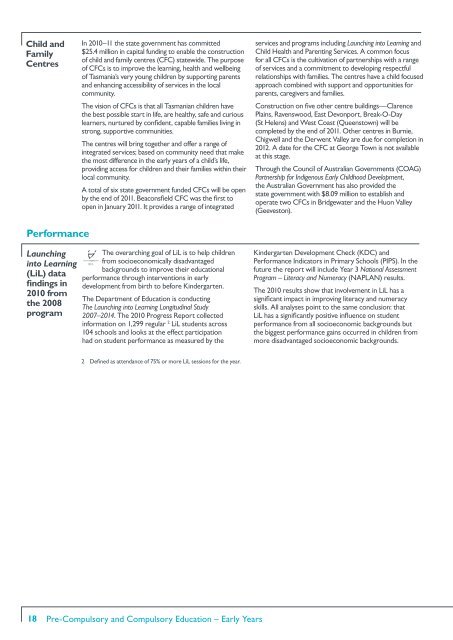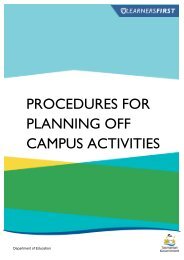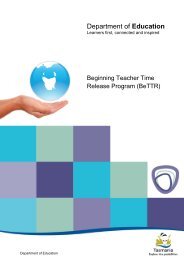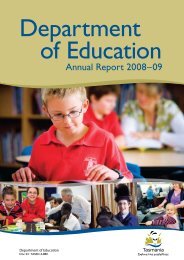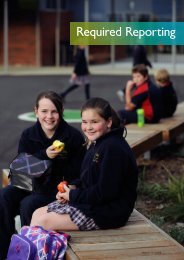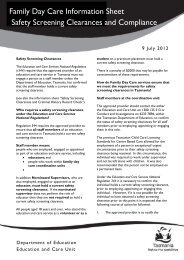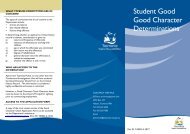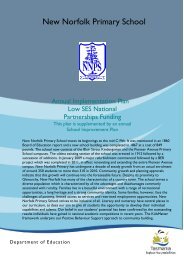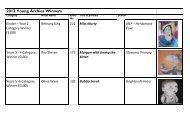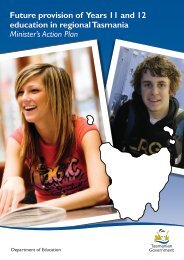Department of Education
DoE Annual Report 2010-2011 - Department of Education
DoE Annual Report 2010-2011 - Department of Education
- No tags were found...
Create successful ePaper yourself
Turn your PDF publications into a flip-book with our unique Google optimized e-Paper software.
Child and<br />
Family<br />
Centres<br />
In 2010–11 the state government has committed<br />
$25.4 million in capital funding to enable the construction<br />
<strong>of</strong> child and family centres (CFC) statewide. The purpose<br />
<strong>of</strong> CFCs is to improve the learning, health and wellbeing<br />
<strong>of</strong> Tasmania’s very young children by supporting parents<br />
and enhancing accessibility <strong>of</strong> services in the local<br />
community.<br />
The vision <strong>of</strong> CFCs is that all Tasmanian children have<br />
the best possible start in life, are healthy, safe and curious<br />
learners, nurtured by confident, capable families living in<br />
strong, supportive communities.<br />
The centres will bring together and <strong>of</strong>fer a range <strong>of</strong><br />
integrated services; based on community need that make<br />
the most difference in the early years <strong>of</strong> a child’s life,<br />
providing access for children and their families within their<br />
local community.<br />
A total <strong>of</strong> six state government funded CFCs will be open<br />
by the end <strong>of</strong> 2011. Beaconsfield CFC was the first to<br />
open in January 2011. It provides a range <strong>of</strong> integrated<br />
services and programs including Launching into Learning and<br />
Child Health and Parenting Services. A common focus<br />
for all CFCs is the cultivation <strong>of</strong> partnerships with a range<br />
<strong>of</strong> services and a commitment to developing respectful<br />
relationships with families. The centres have a child focused<br />
approach combined with support and opportunities for<br />
parents, caregivers and families.<br />
Construction on five other centre buildings—Clarence<br />
Plains, Ravenswood, East Devonport, Break-O-Day<br />
(St Helens) and West Coast (Queenstown) will be<br />
completed by the end <strong>of</strong> 2011. Other centres in Burnie,<br />
Chigwell and the Derwent Valley are due for completion in<br />
2012. A date for the CFC at George Town is not available<br />
at this stage.<br />
Through the Council <strong>of</strong> Australian Governments (COAG)<br />
Partnership for Indigenous Early Childhood Development,<br />
the Australian Government has also provided the<br />
state government with $8.09 million to establish and<br />
operate two CFCs in Bridgewater and the Huon Valley<br />
(Geeveston).<br />
Performance<br />
Launching<br />
into Learning<br />
(LiL) data<br />
findings in<br />
2010 from<br />
the 2008<br />
program<br />
The overarching goal <strong>of</strong> LiL is to help children<br />
from socioeconomically disadvantaged<br />
3.1.1<br />
backgrounds to improve their educational<br />
performance through interventions in early<br />
development from birth to before Kindergarten.<br />
The <strong>Department</strong> <strong>of</strong> <strong>Education</strong> is conducting<br />
The Launching into Learning Longitudinal Study<br />
2007–2014. The 2010 Progress Report collected<br />
information on 1,299 regular 2 LiL students across<br />
104 schools and looks at the effect participation<br />
had on student performance as measured by the<br />
Kindergarten Development Check (KDC) and<br />
Performance Indicators in Primary Schools (PIPS). In the<br />
future the report will include Year 3 National Assessment<br />
Program – Literacy and Numeracy (NAPLAN) results.<br />
The 2010 results show that involvement in LiL has a<br />
significant impact in improving literacy and numeracy<br />
skills. All analyses point to the same conclusion: that<br />
LiL has a significantly positive influence on student<br />
performance from all socioeconomic backgrounds but<br />
the biggest performance gains occurred in children from<br />
more disadvantaged socioeconomic backgrounds.<br />
2 Defined as attendance <strong>of</strong> 75% or more LiL sessions for the year.<br />
18<br />
Pre-Compulsory and Compulsory <strong>Education</strong> – Early Years


